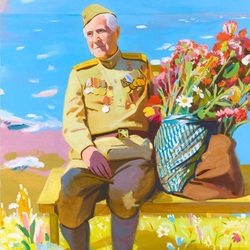In 1892, at an exhibition in Berlin, 55 canvases by the Norwegian painter Edvard Munch were shown, including the first paintings of his large cycle "Frieze of Life". This exhibition caused great controversy, in which the opinions of the adherents of the Kaiser regime clashed, and on the other hand, of progressive artists. No sooner had the exhibition opened than some immediately demanded its closure: "Out of respect for art and the honest name of the artist." The first to demand the closing of the exhibition was the painter of the Kaiser's regime, Anton von Werner, which was strongly opposed by Max Liebermann and some other artists. The first found it difficult to agree with the independence of Munch, who boldly stepped over the framework of naturalism, and the German press wrote about the Norwegian artist as if he were crazy. He was scolded in the big city, and so far there were few people who liked his art. But soon the number of friends began to increase rapidly, and young poets wrote especially well about Munch. The storm played out around his name lifted Munch one step higher on the ladder of fame, and the closing of the exhibition that followed soon only contributed to Munch's wide popularity abroad.
Over the course of his long life, the Norwegian artist Edvard Munch - a painter, draftsman and printmaker - created an astounding number of works: from miniature graphic sheets to large-scale canvases. His legacy is more than 1000 oil works, more than 15,000 prints, almost 4,500 drawings and watercolors. It has truly become Norway's national pride. However, the significance of Munch as an artist is not only in the diversity of his art, but also in the special philosophy of the master, in his ability to ambiguously see and interpret the world around him. Munch himself has repeatedly said that he portrayed not just what he saw, but what aroused a philosophical reaction in him. This vision of the world became decisive for both Munch the painter and Munch the graphic artist. He was obsessed with work and said about it himself: “Writing for me is sickness and intoxication. A disease that I do not want to get rid of, and intoxication in which I want to stay. " Almost all of his works are always based on personal experiences and a unique perception of life. His paintings are imbued with a tragic sense of being, a mood of despair and pessimism.
A special period in the work of Munch is the 90s of the last century. It was at this time that he creates works in which the theme of suffering and loneliness takes on an emphatically gloomy color. The main thing for the artist is the depiction of the “state of the naked soul”. No wonder his paintings bear names that summarize formulas, concepts, moods, states: "Despair", "Fear", "Break", "Melancholy", "Jealousy", etc.
Images of slowly fading life (sick and dying) have appeared on Munch's canvases more than once before. In particular, a whole series of paintings and prints "Sick Girl" is dedicated to this. The consistent development of this theme, the search for its various solutions have become an integral part of Munch's creative method. Thus, real objects and figures of people on his canvases turn into spots of black and white contrast; the space of the premises is barely indicated by the silhouettes of frozen figures; faces are likened to mournful masks, symbolizing human grief (1896 painting "Death in the sick room").
Especially vividly the figurative system of symbolism found its expression in the cycle of his works under the general title "Frieze of Life". Edvard Munch himself said that this is a poem about life, love and death, on which he worked for thirty years. He conceived it as “a cycle of decorative painting, like a canvas of an ensemble of life. In these pictures, behind the winding line of the coast, there is always an undulating sea and under the crowns of trees its own life unfolds with its whims, all its variations, its joys and sorrows. " "Frieze of Life" includes such paintings as "The Kiss", "Barca of Youth", "Vampire", "Madonna" and others. The theme of the largest painting from this cycle - a man and a woman in the forest - may somewhat fall out of the general tone of other paintings, but it is a necessary link in a chain.
In the 1892 drawing Despair, Munch made the following entry: “I was walking along the road with two comrades. The sun was setting. The sky suddenly turned blood red and I felt an explosion of melancholy, gnawing pain under my heart. I stopped and leaned against the fence, dead tired. Blood and flames lay over the blue-black fjord and the city. My friends continued to walk, and I was left behind, trembling with fear, and I heard an endless cry piercing nature. " Subsequently, these impressions became the basis for the idea of the painting The Scream, which Munch painted in 1893, and then repeated it several times in an engraving.
A lonely human figure seems lost in a vast, oppressive world. The outlines of the fjord are only outlined by meandering lines - piercing stripes of yellow, red and blue. The diagonal of the bridge and the zigzags of the landscape lend powerful dynamics to the entire composition. The person's face appears to be a faceless, frozen mask that emits a cry.
The tragic grimace of the man's face is contrasted with the peaceful figures of two men. Stenersen saw in Munch's painting the overwhelming fear of a weak man, paralyzed by the landscape, whose lines and colors moved to strangle him. Indeed, the painting "The Scream" is the apogee of psychological generalization. Munch's painting in this picture has reached exceptional tension, and the canvas itself is likened to a plastic metaphor of human despair and loneliness.
The artist himself - silent and unsociable, gloomy and suspicious, soft and touchy, doubting and uncompromising - found it difficult to get along with people. And although he had quite a lot of friends, he preferred loneliness and at the same time still strove to be among them.
The motives of death and fear (along with erotic motives) are characteristic for all paintings of the cycle "Frieze of Life", and the methods of symbolism used in it are not just a tribute to one of the artistic movements of that time, Munch was long under his influence. At this time, the picturesque language of Van Gogh was especially close to him.
Polish critic Art. Przybyshevsky wrote about the painting: "Scream"! It is impossible even to give an idea of this picture - all its unheard-of power is in color. The sky raged with the cry of Eve's poor son. Each suffering is an abyss of musty blood, each extended howl of suffering is a club of stripes, uneven, roughly displaced, like boiling atoms of nascent worlds ... And the sky is screaming - all nature is concentrated in a terrible hurricane of screaming, and in front, on the platform, there is a man and screams, clutching his head with both hands, for from such screams veins burst and hair turns gray.
Share the jigsaw puzzle
| Pieces | 192 |
| Size | 792x1056 |
| Complexity | simple |
| Added | oreshek89 |
| Published | 7/2/13 |
| Players | 368 |
| Best time | 00:03:13 |
| Average time | 00:41:43 |
























Jigsaw puzzle comments
Add a comment